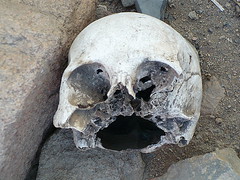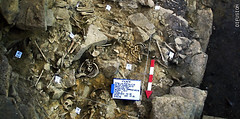Every tourist who visits the colonial heart of Lima visits the San Francisco convent and descends into the depths of its catacombs, filled with the bones of the first generations of Spanish settlers. […] The church is also home to one of Lima’s most important libraries. Built in the 18th century, 25 thousand volumes of books are found here, many are now almost 500 years old. The furniture found here is original, the cedar-wood chairs and tables were once used by Franciscans when studying. [..]
Category: "Lima City Guide"
Big Mouth Magaly sent straight to jail
The whole legal debacle started nearly a year ago when a scandal involving the Peruvian National Soccer Team’s sexual rendezvous at a posh hotel paid for by the Federation came to the public’s attention. If there’s one thing that anybody in Peru knows is that the National Soccer Team is never shy of a shameful scandal!
Medina accused pretty boy Paulo Guerrero, a member of the team, of sneaking out of the hotel to go wine and dine a Peruvian model at U.S. based restaurant chain, TGIFridays in the Limean district of Miraflores. On her program Medina presented videographic evidence that was later debunked by the Federation. (Talk about an impartial investigation!)
University of San Marcos
San Marcos was founded in 1551 as the Real y Pontificia Universidad de la Ciudad de los Reyes de Lima (Real and Pontifical University of the City of the Kings of Lima), less than two decades after the founding of the city of Lima. With a royal decree issued by the King of Spain Carlos I and with a papal bull, it claims to be the first officially recognised university in the Americas – Santo Domingo’s was founded first at the time of the conquest of Peru, but didn’t receive recognition from the King until afterwards.
Perú, Mucho Gusto – Primera Feria Internacional de Lima
Lima’s top chefs unite through the Peruvian Society of Gastronomy and Peru’s tourism and exports promotions agency PromPeru to bring the world the First International Fair of Lima, a gastronomic fair of epic proportions.
Bar Maury and the Pisco Sour
Californian immigrant Victor Morris arrived in the city in the early 1900s and set up a bar that operated until 1933.
It is said that it was here in Bar Morris that the Pisco Sour was first conceived, invented either by Victor or one of his bar staff, based on the recipe for whiskey sour.
The new cocktail was a huge hit, and the city’s biggest hotels, such as the Hotel Bolivar and Hotel Maury began serving their own versions to their international clients.
Bar Maury took up the mantel, and according to barman Eloy Cuadros, who is now part of the furniture, it is here the recipe was perfected and it is their version that has spread across the country. It seems very plausible – Eloy served me the best Pisco Sour I have ever had.
Peruvian Pisco Conquers the World
It was not much more than a century ago that, thanks to a bar in San Francisco’s Bank Exchange, the then little-known national spirit of Peru started making an impact on the international stage. Since then, due to under-appreciation by Peruvians, Chile sneakily claimed ownership of the Pisco brand, making and exporting a greatly inferior mass-produced imitation product that had run the spirit’s reputation abroad into the ground. For many outside Chile, Pisco was now considered junk.
Victims of the Boom
As property prices and rents sky-rocket, and Peru’s economy enjoys its best rates of growth ever, some are left behind. Not able to pay more for rent and with nowhere else to go, this family has found themselves out on the street, evicted by the property owner who wants to cash in and sell the building that was once the family’s home for new construction.
Glorious Pre-Columbian Lima
When Francisco Pizarro arrived in the Rimac valley, founding the city of Los Reyes on the 18th of January 1535, he arrived in place quite different from what you might imagine. Here was an expansive green and fertile land, in the middle of the Peruvian desert coast, home tens of thousands living under the rule of the Incas. Where Lima is found today was once a land of pyramids and palaces, cities and farms, with complex irrigation canals spanning kilometres in length bringing water to every home.
Taulichusco, Lima’s Last Curaca
The Inca Empire had all but collapsed, the Inca capital of Q’osco had been conquered and a puppet emperor placed on the thrown. By following the Inca road from Jauja to Pachacamac, conquistador Pizarro was back on the coast with many of his men looking for a place to found his city. The choice was obvious… the green paradise spanning out from the river Rimac, a vast urban and agricultural area home to tens of thousands of indigenous who had transformed the desert with complex irrigation systems and who had constructed countless towering truncated pyramids that could be seen for miles around.
Maranga and the Lima Culture
In the heart of Pre-Columbian Lima, at the time of the arrival of the Spanish, a vast city was found south of the Rimac River between modern day Lima and Callao. Certainly the administrative centre of power in northern part of the Inca province of Ischma, with Pachacamac an important centre of the south, this city was built long before by the native “Lima Culture” who lived here. Today most of this important complex has been destroyed through the efforts of the Peruvian Government, the University of San Marcos and the Peruvian people in the earlier part of the last century – a time when Peruvians couldn’t care less about their ancient past. Remaining though, and some now finally being restored, are several large huacas, pyramidal mounds, that bare testament to Lima’s long history.
Huaca Mateo Salado
Found at at the Plaza de la Bandera where the district of Pueblo Libre meets Breña and Lima Cercado, the ruins of five pyramids that make up this Lima Culture complex called Huaca Mateo Salado tower over the surrounding modern houses.
El Hueco – The Hole
There was supposed to have been a Government building here, a twin tower the same as the one that is found across the road, but the utter collapse of the Peruvian economy under the stewardship of Alan García put an end to construction before it even began, leaving a huge hole in the ground where the foundations were supposed to be.




![Fujimori’s mega-trial draws to a close [Featured]](http://newsimg.bbc.co.uk/media/images/44791000/jpg/_44791276_fujimori_afp226b.jpg)



![Drug Lords vs. Chocolate: From Coca to Cacao in Peru [Featured]](http://farm1.static.flickr.com/55/112311448_4082aa7aa5_m.jpg)

